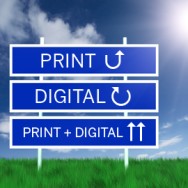Print & Digital is The Way to Go
Posted on Oct 31, 2012 in Design/Publishing/Trends, Marketing/Sales/Advertising

Why a Print Magazine with a Digital Offering will Survive
Having been in the advertising sales world for more than a few years now and having worked on a variety of publications – some print only, some print with a digital version and some digital only – it has been interesting to see how potential advertisers view each platform. A recent Adweek article by Lucia Moses on Newsweek’s move to an all-digital platform has spurred lots of conversation. When you take print out of the equation, what are the direct consequences to both advertising dollars and subscribership? Here are my observations (100% my opinion only). I welcome your comments.
Print Magazine Only
Print only versions are great to attract advertising, but have challenges when it comes to marketing. “Can you send me a link to your digital version?” That is a question that I guarantee will be asked. “Well, we’re only in print, but I’m happy to drop a copy in the mail.” Don’t think for a minute that snail mail still isn’t utilized to market a magazine. It may take an extra step in the sales process and a little more time, but it oftentimes accomplishes the same end result – an ad sale. It also puts a copy in their hands.
Digital Magazine Only
This obviously is a cheaper way to produce a magazine since there aren’t any print and postage costs involved. To a potential advertiser this means the ad rate should be significantly less than a printed version. And for all intensive purposes that is an accurate assumption. There should still be a reader-based rate for advertising in a digital version, but not at the same rate as a printed magazine. I’ll admit e-magazines have some logistical barriers on devices such as tablets and iPhones; but, they do perform well on my 17-inch laptop. Still, it doesn’t provide the same ease of reading as an actual printed magazine. (One of the best uses of e-magazines is archiving – taking your publication’s relevant information and allowing it to live indefinitely within a searchable online environment.)
Print Magazine with a Digital Version
This is the best solution hands down. Print magazines have and always will have intrinsic value for one simple reason—it is a product that can be held in your hand. An advertiser knows there are hard costs involved in the production of that magazine beyond someone’s salary. It takes dollars, real dollars, to print and ship a print magazine. It takes work to make sure each image is correctly sized so it looks professional when it comes off the press. It takes coordination to make sure articles are received and edited in a timely manner since you have a set time when your publication will be on press and any delay could cost you money. And you can add value to a print ad in the complimenting online version—a link to their ad so they can then track ROI on the digital version, which may frame up to 20% of the advertiser’s overall picture of how their ad is being received by readers.
Should I Go to an All-digital Platform?
So when asked if a magazine should forgo their print version for a strictly digital version, I will say no. If your subscribers or advertisers are decreasing, then you need to take a hard look at your overall publication. The content may not be what it used to be. The design may need a facelift. Your audience may have changed. So, no I don’t think moving to an all-digital platform will stop the sinking ship from taking on water. Going all-digital may allow you time to reorganize, but I think if you are considering this move then you may need to retire the publication, re-evaluate your audience and re-launch a new title in print with a digital component.
— Chellie Thompson, Cofounder, Monarch Media & Consulting, Inc.


